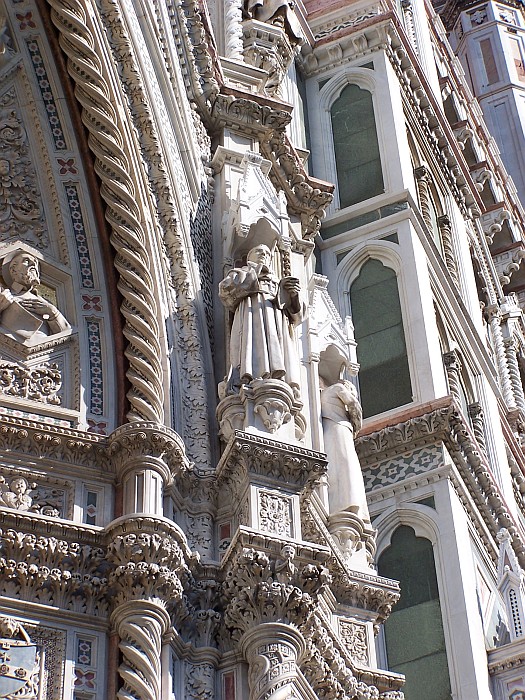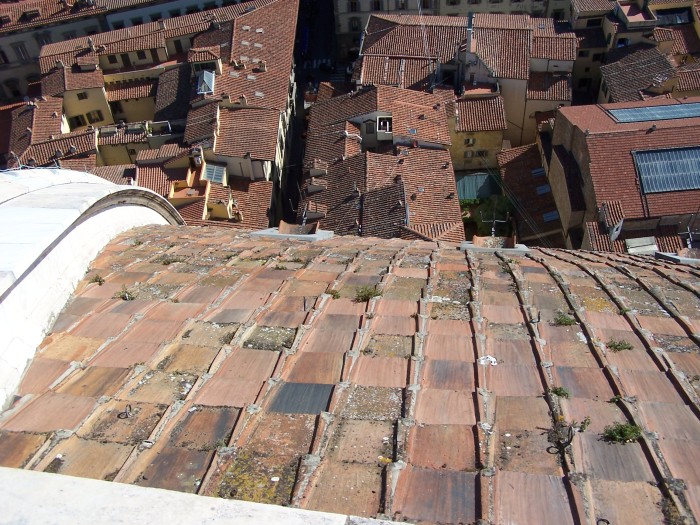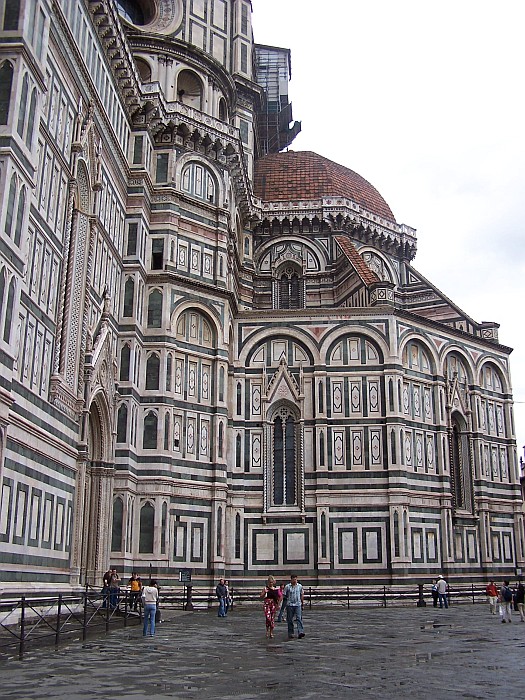

The Cathedral, externally, for all its solemn hugeness, strikes the same note of would-be reasoned elegance and cheer; it has conventional grandeur, of course, but a grandeur so frank and ingenuous even in its parti-pris. It has seen so much, and outlived so much, and served so may sad purposes, and yet remains in aspect so full of the fine Tuscan geniality the feeling for life, one may almost say the feeling for amusement, that inspired it. Its vast many-coloured marble walls become at any rate, with this, the friendliest note of all Florence; there is an unfailing charm in walking past them while they lift their great acres of geometrical mosaic higher in the air than you have time or other occasion to look. You greet them from the deep street as you greet the side of a mountain when you move in the gorge - not twisting back your head to keep looking at the top but content with the minor accidents, the nestling hollows and soft cloud-shadows, the general protection of the valley. Henry James
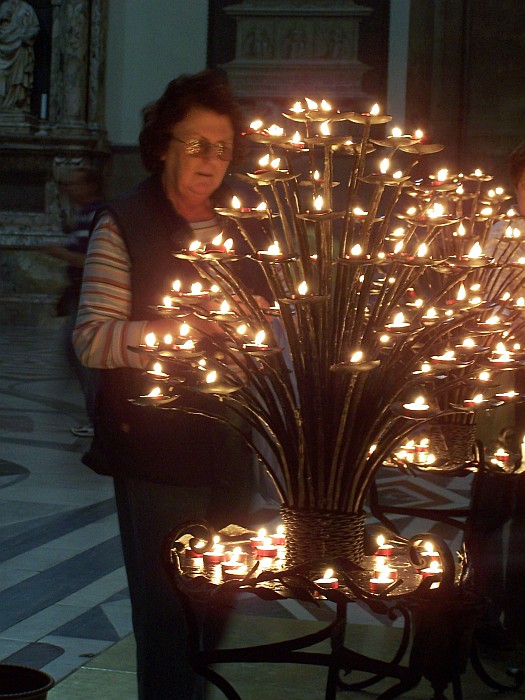
THE INTERIOR
The barren interior of the Duomo astonishes without delighting.
Only the Gothic style is in harmony with a terror-inspiring religion, which says to the greatest number of those who enter its churches: 'Thou shalt be damned.' Stendhal
The Duomo is cold, inimical to worship. It is not a place one wishes to enter again and again, either for spiritual refreshment or for aesthetic pleasure. But I have never known anyone who did not love the candy-striped façade of the cathedral, white, green, red (like sumptuous Christmas wrappings), or Giotto's multicolored Bell Tower, which Longfellow called the lily of Florence blossoming in stone, and which James called the indestructible soul of the city made visible.
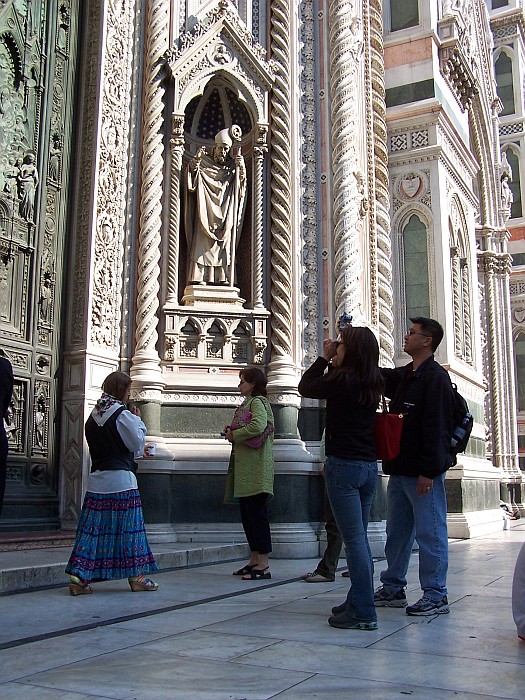
The Duomo, the octagonal green-and-white Baptistery, and the Bell or Lily Tower form the spiritual heart of Florence.
The Duomo stands where once stood the Church of Santa Reparata, a twelve-year-old martyr who rendered military assistance to the citizens of Florence in the fifth century, miraculously appearing in the midst of Vandals and Goths with a lily and a blood-red banner in her hand. She is the Joan of Arc of Florence. (The fate of female saints with military proclivities is either to be forgotten or to be burned.)
When I remember that this is a church dedicated to God and to the Virgin I am confident that since it is being built in her honor she will not fail to give us knowledge which is lacking and to grant strength, wisdom, and understanding to whoever is responsible for the work. Brunelleschi
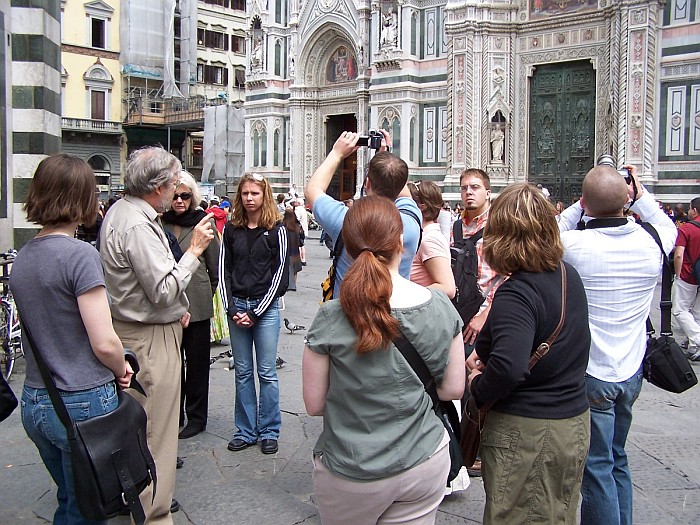
The Florence Duomo is dedicated to Santa Maria del Fiore and is typical of Italian Gothic architecture. The present building was designed by Arnolfo di Cambio (c.1245-1302), one of the greatest architect sculptors of his age, who considerably enlarged the existing structure. This was finished in around 1367 and was completely covered with colored marbles like the earlier Baptistery, although the uncompleted facade was given its covering in the nineteenth century. The Cupola remained unfinished, and in 1421 the polygonal base was erected. Two architects won the competition to design the dome, Lorenzo Ghiberti (1368-1445) and Filippo Brunelleschi (1377-1446), but it was Brunelleschi who actually built it using remarkable technical knowledge to achieve the uniquely beautiful results we see today. Completed in 1436, the Cupola is the most characteristic feature of the Florentine skyline, symbolizing a great cultural tradition and the city's civic awareness.
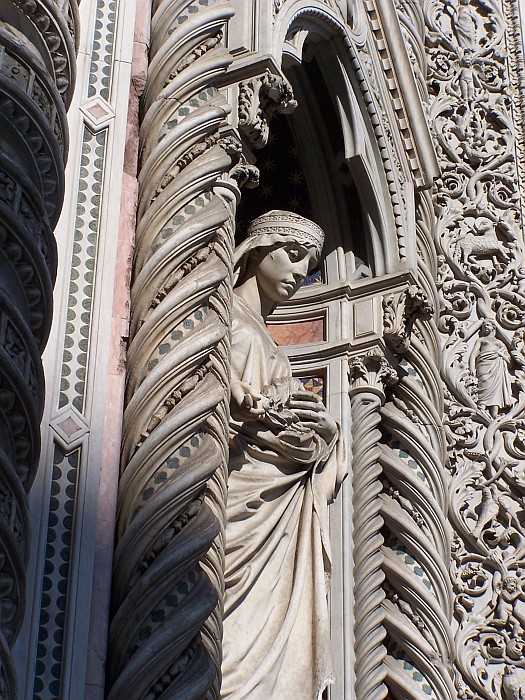
One of the most notable features of the exterior apart from the apses is the beautiful Porta della Mandorla on the north façade, so-called from the large aureole around the Assumption of the Virgin (mandorla = almond) sculptured by Nanni di Banco (1380/90-1421). Inside are several important works of art, offset by the architecture's taut Gothic forms, completely different from medieval buildings north of the Alps. Of primary importance are the two frescoes on the north wall showing the equestrian monuments of the "condottieri" John Hawkwood and Niccolò da Tolentino by Paolo Uccello (1436) and Andrea del Castagno (1456). The fresco decoration of the clock on the inside wall, showing four vigorous heads of male saints, is by Paolo Uccello.
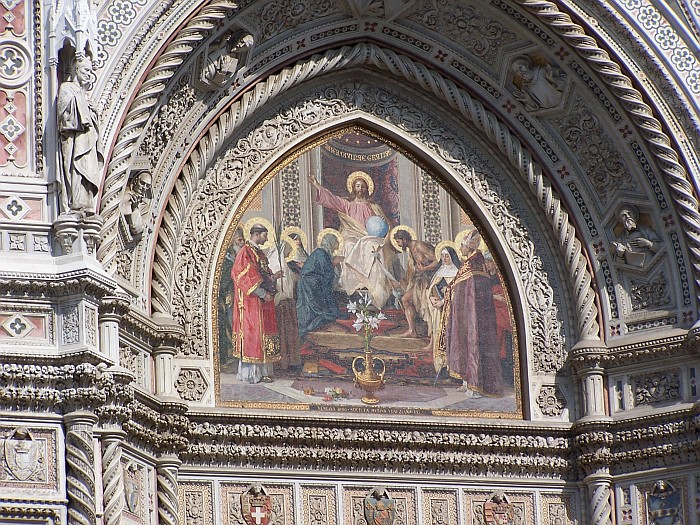
Many of the sculptures from the Duomo are now kept in the Museum of the Opera del Duomo, but others are still in place, such as the lunettes by Luca della Robbia above the doors of the Sacristy or the bronze door of the Mass Sacristy. The great Pietà by Michelangelo (c. 1553) has been moved to the Opera. The splendid stained glass windows should not be forgotten, mainly executed from 1434-1445 to the designs of such important artists as Donatello, Andrea del Castagno and Paolo Uccello. Also notable are the wooden inlays of the Sacristy cupboards to the designs of Brunelleschi, Antonio Del Pollaiolo and others. The cupola's interior remained undecorated until Giorgio Vasari (1511-1574) and Federico Zuccari (c. 1540-1609) painted a huge and not entirely satisfactory Last Judgement there. The "Cupolone" or huge dome remains, with the cathedral bell tower known as the " Campanile di Giotto ", the most striking feature of any view of the city. Giotto, the famous painter and architect designed the tower, although at his death in 1337 only the lowest part was complete. Work was continued under Andrea Pisano (c. 1290-1349) and Francesco Talenti (active 1325-1369) who completed the structure repeating the decoration of marble relieved by windows; the traditional pointed finial was never added. The sculptured marble panels illustrate a cycle centered around the theme of the order of the universe.
· Neo-Gothic façade (added in 1871-87) echoes style
of Campanile
· marble pavement (16th century) - laid out as a maze
· octagonal marble sanctuary around high altar decorated
by Baccio Randinelli
· Brunelleschi's Dome - largest of its time - stands 348
feet high
· built without scaffolding - 463 steps
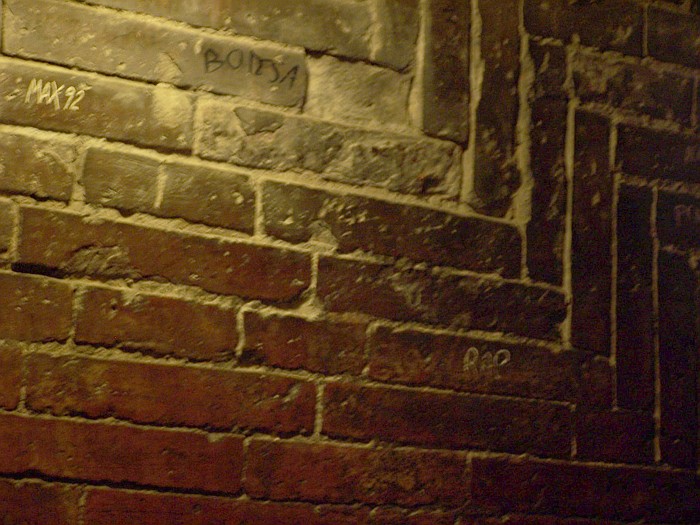
· bricks of varying sizes were set in a self-supporting herringbone
pattern
· this technique was copied from the Pantheon in Rome
Michelino, Dante e il suo poeme
Two scenes from Florence beautifully illustrate the power of scientific revolutions to alter our view of the geometry of existence. A painting by the fifteenth-century artist Michelino hangs in the great cathedral of Santa Maria del Fiore. Entitled Dante e il suo poeme, it shows the entire universe on a single canvas. The earth occupies the center, symbolized by the city of Florence, with Dante in the middle and Brunelleschi's magnificent dome for the cathedral to his left (an anachronism, to be sure, for Dante died in 1321, and Brunelleschi raised the great dome a century later). At Dante's right, the souls of the damned move downward to the Inferno while those ultimately to be saved slowly mount the spire of Purgatory. The seven semicircles at the top are the seven planets of Ptolemy's earth centered system (the five visible planets plus the sun and moon). The farthest realm of the fixed stars occupies the upper corners.
If we take a short walk to the Franciscan church of Santa Croce we find the tomb of Galileo. The face of his statue looks upward toward his expanded heavens, and he holds a telescope in his right hand. His left hand envelops the small and insignificant sphere of the earth. In two centuries, the earth had been displaced from centrality in a limited and subservient universe to peripheral status as a little hunk of stone suspended in the midst of inconceivable vastness. Stephan Jay Gould, Natural History, August, 1995.
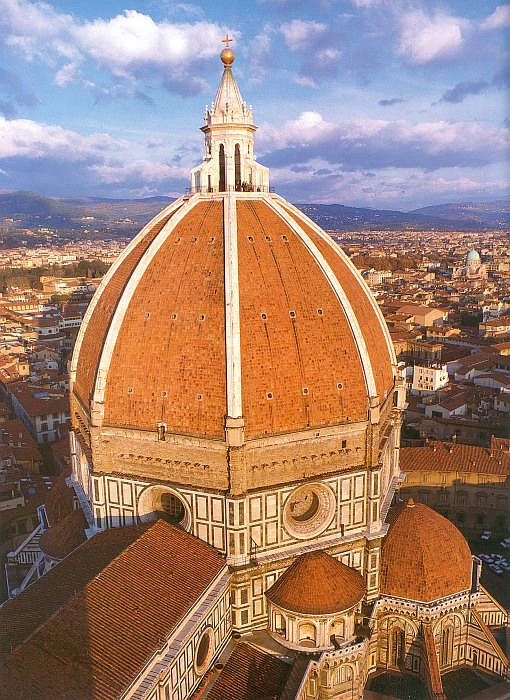
The Dome
Vasari
· Last Judgment frescoes in dome

Chapels at East End
· three apses house five chapels each - crowned by miniature
copies of the dome
· 15th century stained glass by Lorenzo Ghilberti
Du Fay, Nuper rosarum
· motet composed for dedication of Cathedral, 1436 - refers
to Pope Eugene IV
· Eugene as successor to St. Peter symbolized with imitation
- emphasis on the number 7 (Church)
· text arranged in four seven-line strophes
· two repeating tenors of 14 notes each (double vaulting
of church) - a 5th apart
· division of work into 4 sections related durationally in
ratios 6:4:2:3 mirror dimensions of Solomonís temple: 60x40x20x30 cubits
(I Kings 6)
· Tenor is an introit (Mode 2) for dedication of a Church
(Liber Usualis, p. 1250)
· This work is a petition to Mary, in whose name the church
was dedicated
TEXT
Nuper rosarum flores The rose blossoms
Ex dono pontificis recently given by the Pope,
Hyeme licet horrida despite the winterís cold
Tibi virgo celica have continued to adorn this temple
Pie et sancte deditum with its great device,
Grandis templum machine piously and solemnly dedicated
Condecorarunt perpetim. to you, heavenly Virgin
Hodie vicarius Today the vicar of Jesus
Jesu Christi et Petri Christ and the successor
Successor Eugenius of Peter, Eugenius,
Hoc idem amplissimum has deigned to consecrate
Sacris templum manibus this same most splendid
Sanctisque liquoribus temple with his sacred hands
Consecrare dignatus est. and holy oils.
Igitur, alma parens Therefore, kindly parent
Nati tui et filia, and daughter of your Son,
Virgo decus virginum, you, O Virgin, glory of virgins,
Tuus te Florencie your devoted inhabitants
Devotus orat populus, of Florence implore
Ut qui mente et corpore that he who with pure mind
Mundo quicquam exorarit, and body has made some entreaty -
Oracione tua By your prayer
Cruciatus et meritis and by the merits of the crucifixion
Tui secumdum carnem of your Son, his Lord
Nati domini sui made flesh - will
Grata beneficia deserve to receive
Veniamque reatum welcome favors and
Accipere meretur. Amen the forgiveness of sins. Amen.
TENOR: Terribilis est locus iste. Awesome is this place.

Lorenzo - Blood in the Cathedral
Three people were always present at the feasts and banquets offered by Lorenzo and Giuliano: Francesco de' Pazzi, Bernardo Bandini, and the captain of fortune Giovan Battista Montesecco. They participants in the conspiracy to kill both Medici brothers, a plot to which old Jacopo de' Pazzi reluctantly adhered.
This plot originated in Rome where it received the support of Pope Sixtus IV, who was aggravated by Lorenzo's hostility towards his nephew Girolamo Riario, who aspired to take possession of Imola. For this reason the Pope had taken away the management of the papal treasury from the Medici bank, and given it to the Pazzi. In addition, he had appointed Francesco Salviati, Archbishop of Pisa against Lorenzo's will.
The conspirators, with the cooperation of the Riario and Salivati families, waited for the right moment to carry out their plan. In spring 1478, Archbishop Salviate decided to sent to Florence Raffael Riario, still a very young student at Pisa, appointed Cardinal by the nepotism Pope. He was supposed to act as a lure, so that the conspirators could do away with Lorenzo and Giuliano in one blow. Lorenzo greeted Riario in the Pazzi Villa at Montughi, but Giuliano was ill and could not attend. The cardinal was then invited to the Medici Villa at Fiesole, where the killing trio also went. However, Giuliano was absent again.
Finally Archbishop Salviati invited Cardinal Riario to a Mass in the Duomo, to be followed by another reception in the palace of the Via larga. And finally, either before or after or during the meal, the conspirators would have succeeded in stabbing the two brothers. But Giuliano was suffering from a weak stomach and although he would not have attended the meal, would certainly have attended the Mass before. Hence the assassination was planned at the altar, just as the priest raised the host above the kneeling brothers.
When the bell that is rung during the elevation rang, Salviati was to go the Palazzo Vecchio and kill the Gonfaloniere. Francesco de' Pazzi and Bernardo Bandini were to kill Giuliano, while Giovan Battista da Montesecco would take care of Lorenzo himself. But when Battista was informed he would have to kill Lorenzo during the Elevation, he refused to commit sacrilege. A priest, Stefano da Bagnone and a notary Antonio da Volterre were selected as substitutes.
The canons came out of the sacristy, where the young Cardinal was preparing himself for the ceremony, but the two brothers had not yet appeared. When the conspirators finally saw the Medicis emerge from the Via Larga palazzo, they rushed to them, embraced them to see if they were wearing armor or had concealed weapons. Only Lorenzo had a sword.
The Introit, the Epistle, the Gospel were read; it was time for the consecration. The altar boy rang the silver bell, the congregation kneeled, the Host raised when
Bernardo Bandini and Franceso Pazzi put Giuliano between them. Bandini is the first to pierce his chest. Still half alive, Giuliano tries to flee, followed by the other. After a few paces, his strength failing him, he falls to the ground. Francesco Pazzi leaps on him, striking him again and again. This is how they killed that fine young man, my sweetest of friends.
At the same time the henchmen assigned to kill Lorenzo were onto him. The man from Volterra takes him by his shoulder and strikes at his throat. Fearlessly, he throws off his cloak; wraps it over his left arm; pulls out his sword; but in trying to get away is wounded at the neck. The daring, brave young man pulls out his dagger, looks around him and defends himself. The thugs flee in dismay.
But he also flees inside the sacristy followed by his faithful Poliziano, who closes behind him the heavy bronze doors, designed by Luca della Robbia, while Antonio Ridolfi sucks Lorenzo's wound, for fear the blade may have been poisoned. Mass is interrupted: the Cathedral is in tumult. A friend of the Medici climbs onto the organ (the della Robbia cantoria now in the Opera of the Duomo Museum) from where he can see Giuliano's body stretched on the floor, and informs his brother of the event. Escorted by a group of armed friends, his neck bound as well as could be expected, Lorenzo rushes to the palace of the Via Larga. The first thought to come to his mind is to ask for help from the Sforze in Milan. He orders for paper, pen and ink and writes frantically:
My illustrious Lords. They have killed my brother this very moment and I am in the greatest danger for my safety; therefore, my dear Signori, the time has come for you to help your servant Lorenzo. Send whatever men you can as hastily as possible to be the safety and shield of my state as they have always been; Florence 26th of April. Your servant Lorenzo de' Medici.
Meanwhile, according to the plans of the conspiracy, Archbishop Salviate arrived at the Palazzo to take possession of the Signoria, but was arrested by Gonfaloniere Petrucci. Unaware of the events in the Cathedral, Petrucci suspected the betrayal. The Pazzi and their followers stormed through the city on horseback, shouting: "Liberty, liberty!" in the hope of arousing the populace. The shouts, in answer were: "Palle, palle!" because the sacrilegious assassination had aroused the Florentines to side with the Medici.
One hour later, Archbishop Salviati was dangling by his neck from the window of the Sala dei Duecento, and six other conspirators joined him in the macabre retinue, outside other windows. Next to him in sacred vestments hung the naked body of young Francesco de' Pazzi. The old father, Jacopo, who had fled to the mountain village of Castagno was captured by the villagers and brought back to the city, to be executed in Piazza della Signoria. The two clumsy priests, who had not succeeded in fulfilling their grim commission, were also executed. Giovan Battista Montesecco was arrested, tortured and ultimately decapitated.
Another eighty, guilty and innocent, were sacrificed on the tomb of "bel Julio." Many others were banished, including Guglielmo dei Pazzi, whose life was spared as he was the husband o Lorenzo's sister, Bianca, and Piero Vespucci, who was a relative of the beautiful Simonetta, whom Giuliano had loved so deeply. Only Bernardo Bandini succeeded in escaping, taking refuge in Constantinople. But Lorenzo enjoyed such widespread prestige there that the Sultan had him arrested and sent him back in chains to Florence where he was hanged a year and a half after the conspiracy.
To prolong the memory of that execution, Botticelli was commissioned to paint the hanged figures on the wall of the palace, "above the Dogana," while Lorenzo wrote a harsh epitaph for each of them. The one for Bernardo Bandini read:
I am Bernardo Bandini, the new Judas,
A murderous traitor in church I was,
A rebel only to receive a more cruel death.
The figure hanging from the windows of the Palazzo della Signori offered a spectacle of sorrow and bitterness, Leonardo da Vinci, 26 years old, made a drawing of one of them, coldly taking down the color of the clothes he was wearing. Bargellini
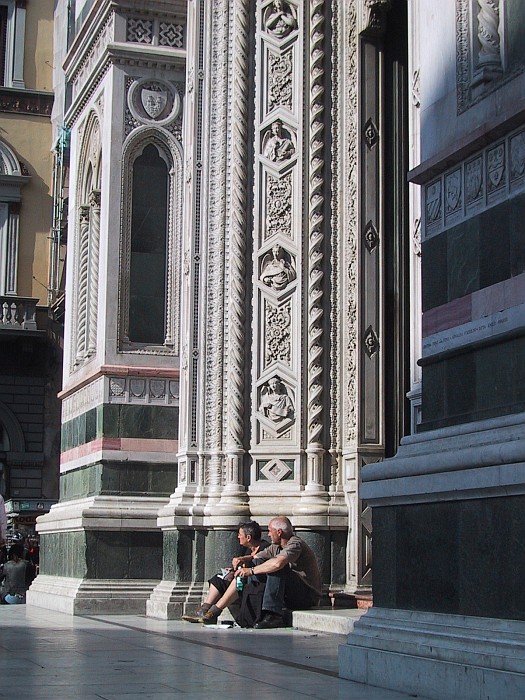
San Reparata
The remains of Santa Reparata provide important information about the art, history and topography of Florence. Santa Reparata, the old cathedral of Florence, kept this dedication until 1412. Its oldest remains are probably at the same level as the Roman city, or else at that of the Baptistery. In 1965 excavations were begun inside the cathedral to recover remains of the oldest church on the site; these brought to light unexpected networks of building pointing to the existence of two churches prior to that of Santa Reparata. The first may be dated to round 780 and from it was found a beautiful parapet carved with figures. After this it seems that the next changes in the building took place in Romanesque times, when the pavement was raised by as much as one metre; the third and last transformation took place as is well known in the thirteenth century when the pavement was again raised to within 90 cm. of its present level. Among all these varying pavement levels were found many fourteenth century pietra serena tombstones - now visible - which had been buried as the various changes took place. The polychrome geometric mosaics from the eighth century pavement are also on shown while on the walls are fresco fragments revealing the various phases and styles of decoration. One of the more important discoveries was the tomb of Brunelleschi, which dates from the vear of his death, 1446. A gallery has been created allowing a view of the exterior of the apse, the structure of the old building; using new support and old architectural elements the crypt has been restored to the appearance it must have had for the faithful of the past.
crypt contains remains of the 4th century church demolished in 1296 to make way for the cathedral
